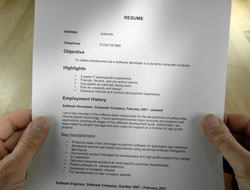Online Class: Fashion Design 101 — An Introduction

no certificate
with CEU Certificate*
-
11Lessons
-
18Exams &
Assignments -
6Hours
average time -
0.6CEUs
Course Description
Fashion Design 101 explains the qualities and skills necessary to become a fashion designer. You'll learn about the many related career opportunities available besides that of fashion design and gain an inside look into today's fashion business.
A fashion career is two-thirds artist and one-third business. Color, pattern making and illustration are all skills a fashion designer must learn in order to put a collection together. You'll learn how becoming a fashion designer involves many core related principles to completely understand the many facets of the fashion business.
This course is ideal for students, seamstresses and anyone interested in the fashion business and design quality. Since a fashion designer wears many hats, you will gain knowledge about everything from haut couture to budget clothing and that design is about performing research, applying knowledge of fabric, coordinating color and texture, and monitoring quality and fit.
People who strive to become fashion stylists have a profound knowledge of fashion, a fierce personal style and a knack for putting together complete outfits for themselves and others. This course provides lots of different information about the fashion world to help you better understand why it is important to learn about fabrics, prints and other technical aspects of fashion in order to jump-start your fashion career.
Course Motivation
So you want to take the plunge and become an aspiring fashion designer. Perhaps fashion design will become a serious career for you, or maybe you are a fashion enthusiast and want to learn the ins and outs of dressing more stylishly. You've become fascinated by Project Runway and the skills and qualities needed to become a fashion guru. Words of caution! If you want to enter a world the likes of Coco Chanel, you must be totally and utterly obsessed with fashion.There are many elements of the profession: You could supervise a design team at a clothing company manufacturing contemporary fashion, or you may wish to manufacture your designs under your own label. Like most of the world's successful designers, having your own clothing line can be stressful, takes infinite time, dedication, and hard work -- not to mention the ongoing supply of cash to keep yourself above poverty level.
History of Fashion Design
Charles Frederick Worth rose above being a simple seamster in the 19th century. Women of that era paid special attention to what royalty was wearing, and frequently hired a dressmaker to sew a copy. When Worth set up his fashion design house in Paris, he was the first commoner to actually influence his customers on the subject of what to wear.
Worth's house of fashion became so famous that people throughout the world equated the name and the face to fashions emanating from his fashion house.
For aspiring designers, it is important to acquaint themselves with fashions from different eras, because in the fashion world, much like anything else, history does repeat itself. Not only do designers acquaint themselves with silhouettes, patterns, and fabrics, but with past designers, as well. The world of fashion is often inspired by a past era or design, and today's designers must develop a subtle way of expressing a particular era by mixing their own ideas with those of the past. Fashion schools give their students access to magazines and books that span many decades as a significant tool for today's fashion design.
In addition, it helps to be a fashion activist, who is creative and particular about finishing touches to a garment. A successful fashion design, as always, requires patience and vast attention to detail.This includes not only the completed garment, but accessories, as well. Visiting fashion museums, like the Costume Institute at the Metropolitan Museum of Art in New York, can be the starting point for a new designer.The ability to replicate or update the fashion looks of the past will be a valuable tool.
A treasure trove of vintage clothing can be found in vintage clothing shops, and in thrift shops. Pairing modern day wear with a period classic look can have a dramatic and trend-setting global effect. Coco Chanel (1883 to 1971) got her start by designing hats. She then pioneered clothing styles, introducing the proper use of jersey and knitwear for special occasions. From this, came the little black dress and bold costume jewelry.
Much has changed, since Worth's time. Modern fashion design is now divided into two categories:
Fashion is:
o Visionary
o Innovative
o Challenging
o Unique In design
o Artistic
o Courageous
o Whimsical
Clothing is:
o Homogenized
o Undefined
o Ordinary
o Not innovative
o Lacking real skill
o Common
o Off the rack
Perhaps the greatest challenge for fashion designers today, is managing stress, maintaining energy and innovation, and competition awareness. Staying ahead of the game is what makes a fashion designer become noticed.
With proper training, you are more likely to carve a slot for yourself as a fashion designer. And yet many people rise from humble beginnings to become a fashion celebrity.
- Ralph Lauren and Michael Kors had no formal training. Lauren's Polo domain was founded on a small collection of ties; Kors built a following by selling his designs from a high-end New York shop.
- Laura Ashley was a secretary before getting her break.
- Vera Wang began designing at 39, when she couldn't find a suitable wedding gown for herself, a mature bride.
Why College?
Like most art forms, fashion is an international language. Apparel and accessory shopping is a cultural, social, and financial fact -- a phenomena as fascinating as any of the fine arts.
If you really have what it takes, you would do yourself and your fashion design career a huge favor and build a strong foundation by getting a fine arts degree in fashion from a prestigious school. A commendable school will add credibility to your resume and your craft.
Talent for fashion design is not necessarily like a talent for drawing or sewing, although both are valuable assets. Runway models are a far cry from the average man or woman. A fashion designer should have the ability to successfully camouflage certain areas on a person's body by applying a refreshing approach to today's contemporary design, and showing-off the beautiful assets of a woman. Education can only expand this talent to a higher stature.
Selecting Courses:
Many colleges have fashion programs, but those that can advance your career are few. Competition is fierce and colleges tend to be very selective. After you send in a portfolio of sketches, if you are one of the lucky ones to be accepted, it is a major step toward becoming a designer.
It's a good idea to learn to sew and operate a sewing machine before you apply to college. If you can't draw, start by taking art classes. You will also learn to understand form and proportion. Most fashion designer programs are three to four years long. During this time, you will be taking fine arts classes and continuing to study drawing composition and form, which is how you communicate your ideas. You will also learn pattern making and cutting, as well as draping techniques.
A great design school will work closely with the industry, prompting successful designers to mentor graduating students. College is expensive; however, if you are ambitious and work hard, you can apply for grants and even win prestigious awards. At the end of the semester, when graduating students present their collection, many VIPs from the fashion industry attend the shows to scout fresh talent.
Above all, be passionate about your designs, and learn whatever you can from whoever can help you build confidence and gain knowledge in fashion design.
- Completely Online
- Self-Paced
- Printable Lessons
- Full HD Video

- 6 Months to Complete
- 24/7 Availability
- Start Anytime
- PC & Mac Compatible
- Android & iOS Friendly
- Accredited CEUs

Course Lessons
Lesson 1: Historical Content and Education
 Lesson 1 Video
Lesson 1 Video Lesson discussions: Reasons for Taking this Course
Lesson discussions: Reasons for Taking this Course Complete: Lesson 1 Assignment
Complete: Lesson 1 Assignment Assessment: Lesson 1: Historical Content and Education
Assessment: Lesson 1: Historical Content and Education
Lesson 2: Self-Employment or a Top Job
 Lesson 2 Video
Lesson 2 Video Complete: Lesson 2 Assignment
Complete: Lesson 2 Assignment Assessment: Lesson 2: Self-employment or a Top Job
Assessment: Lesson 2: Self-employment or a Top Job
Lesson 3: The Many Languages of Fashion
 Lesson 3 Video
Lesson 3 Video Assessment: Lesson 3: The Many Languages of Fashion
Assessment: Lesson 3: The Many Languages of Fashion
Lesson 4: The Realities of Manufacturing and Product Development
 Lesson 4 Video
Lesson 4 Video Complete: Lesson 4 Assignment
Complete: Lesson 4 Assignment Assessment: Lesson 4: The Realities of Manufacturing and Product Development
Assessment: Lesson 4: The Realities of Manufacturing and Product Development
Lesson 5: Color and Fabric
 Lesson 5 Video
Lesson 5 Video Assessment: Lesson 5: Color and Fabric
Assessment: Lesson 5: Color and Fabric
Lesson 6: Fabric Production
 Lesson 6 Video
Lesson 6 Video Complete: Lesson 6 Assignment
Complete: Lesson 6 Assignment Assessment: Lesson 6: Fabric Production
Assessment: Lesson 6: Fabric Production
Lesson 7: Developing Personal Creativity and Style
 Lesson 7 Video
Lesson 7 Video Complete: Lesson 7 Assignment
Complete: Lesson 7 Assignment Assessment: Lesson 7: Developing Personal Creativity and Style
Assessment: Lesson 7: Developing Personal Creativity and Style
Lesson 8: Defining a Project
 Lesson 8 Video
Lesson 8 Video Assessment: Lesson 8: Defining a Project
Assessment: Lesson 8: Defining a Project
Lesson 9: Fashion Business or Fashion Career
 Lesson 9 Video
Lesson 9 Video Assessment: Lesson 9: Fashion Business or Fashion Career
Assessment: Lesson 9: Fashion Business or Fashion Career
Lesson 10: Marketing Your Fashions: Defining Your Uniqueness
 Lesson 10 Video
Lesson 10 Video Assessment: Lesson 10: Marketing Your Fashions: Defining Your Uniqueness
Assessment: Lesson 10: Marketing Your Fashions: Defining Your Uniqueness
Lesson 11: Processing Orders and Accounting
 Lesson 11 Video
Lesson 11 Video Lesson discussions: Let us know what you think of this course; Program Evaluation Follow-up Survey (End of Course); Course Comments; Reasons for Taking this Course
Lesson discussions: Let us know what you think of this course; Program Evaluation Follow-up Survey (End of Course); Course Comments; Reasons for Taking this Course Complete: Final Assignment
Complete: Final Assignment Assessment: Lesson 11: Processing Orders and Accounting
Assessment: Lesson 11: Processing Orders and Accounting Assessment: The Final Exam
Assessment: The Final Exam
Learning Outcomes
- Describe historical content and education of fashion design.
- Determine whether you want self-employment or a top job.
- Describe the many languages of fashion.
- Describe the realities of manufacturing and product development.
- Identify color and fabric.
- Summarize fabric production.
- Describe developing personal creativity and style.
- Describe defining a project.
- Summarize fashion business or fashion career.
- Summarize marketing your fashions.
- Describe processing orders and accounting.
- Demonstrate mastery of lesson content at levels of 70% or higher.
Additional Course Information

- Document Your Lifelong Learning Achievements
- Earn an Official Certificate Documenting Course Hours and CEUs
- Verify Your Certificate with a Unique Serial Number Online
- View and Share Your Certificate Online or Download/Print as PDF
- Display Your Certificate on Your Resume and Promote Your Achievements Using Social Media

Choose Your Subscription Plan
No Certificate / No CEUs
This course only
| Includes certificate | X |
| Includes CEUs | X |
| Self-paced |

|
| Instructor support |

|
| Time to complete | 6 months |
| No. of courses | 1 course |
Certificate & CEUs
This course only
| Includes certificate |

|
| Includes CEUs |

|
| Self-paced |

|
| Instructor support |

|
| Time to complete | 6 months |
| No. of courses | 1 course |
Certificates & CEUs
Includes all 600+ courses
| Includes certificate |

|
| Includes CEUs |

|
| Self-paced |

|
| Instructor support |

|
| Time to complete | 12 Months |
| No. of courses | 600+ |
Certificates & CEUs
Includes all 600+ courses
| Includes certificate |

|
| Includes CEUs |

|
| Self-paced |

|
| Instructor support |

|
| Time to complete | 24 Months |
| No. of courses | 600+ |
Student Testimonials
- "Participating in this course accomplished my personal goal, which was to jump-start myself into thinking analytically about fashion and about what I want to accomplish as a person-who-designs-for-myself, rather than staring blankly at the pattern books at Joann." -- Wende F.
- "All of it was helpful. This was new information for me." -- Cathy K.
- "All lessons were helpful and the instructor was very knowledgeable." -- Shekhar R.
Related Courses
-
 45 hours
4.5 CEUs
Event Management Course Bundle
+ More Info
45 hours
4.5 CEUs
Event Management Course Bundle
+ More Info
-
 15 hours
1.5 CEUs
Traditional Scrapbooking 101
+ More Info
15 hours
1.5 CEUs
Traditional Scrapbooking 101
+ More Info
-
 7 hours
0.7 CEUs
Wedding Traditions Around the World
+ More Info
7 hours
0.7 CEUs
Wedding Traditions Around the World
+ More Info
-
 6 hours
0.6 CEUs
Etiquette Consultant
+ More Info
6 hours
0.6 CEUs
Etiquette Consultant
+ More Info
-
 9 hours
0.9 CEUs
Party Planning 101
+ More Info
9 hours
0.9 CEUs
Party Planning 101
+ More Info
-
 12 hours
1.2 CEUs
Wedding Planning 101
+ More Info
12 hours
1.2 CEUs
Wedding Planning 101
+ More Info
-
 9 hours
0.9 CEUs
Event Planning 101
+ More Info
9 hours
0.9 CEUs
Event Planning 101
+ More Info
-
 5 hours
0.5 CEUs
Home Safety
+ More Info
5 hours
0.5 CEUs
Home Safety
+ More Info
-
 14 hours
1.4 CEUs
Cake Decorating 101
+ More Info
14 hours
1.4 CEUs
Cake Decorating 101
+ More Info
-
 5 hours
0.5 CEUs
Catering 101
+ More Info
5 hours
0.5 CEUs
Catering 101
+ More Info
-
 3 hours
0.3 CEUs
Tea Parties 101
+ More Info
3 hours
0.3 CEUs
Tea Parties 101
+ More Info
-
 10 hours
1.0 CEUs
Interior Design 101
+ More Info
10 hours
1.0 CEUs
Interior Design 101
+ More Info
-
 9 hours
0.9 CEUs
Landscaping 101
+ More Info
9 hours
0.9 CEUs
Landscaping 101
+ More Info
-
 8 hours
0.8 CEUs
Interior Decorating Made Easy
+ More Info
8 hours
0.8 CEUs
Interior Decorating Made Easy
+ More Info
-
 4 hours
0.4 CEUs
How to Bake Cookies
+ More Info
4 hours
0.4 CEUs
How to Bake Cookies
+ More Info
-
 9 hours
0.9 CEUs
How to Decorate a Room
+ More Info
9 hours
0.9 CEUs
How to Decorate a Room
+ More Info
-
 8 hours
0.8 CEUs
Special Events Planning
+ More Info
8 hours
0.8 CEUs
Special Events Planning
+ More Info







